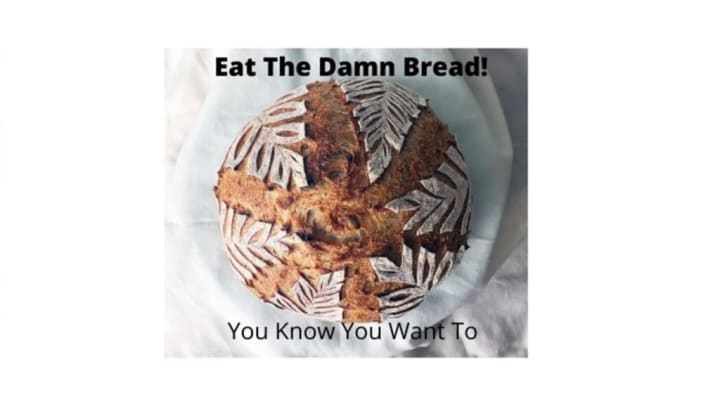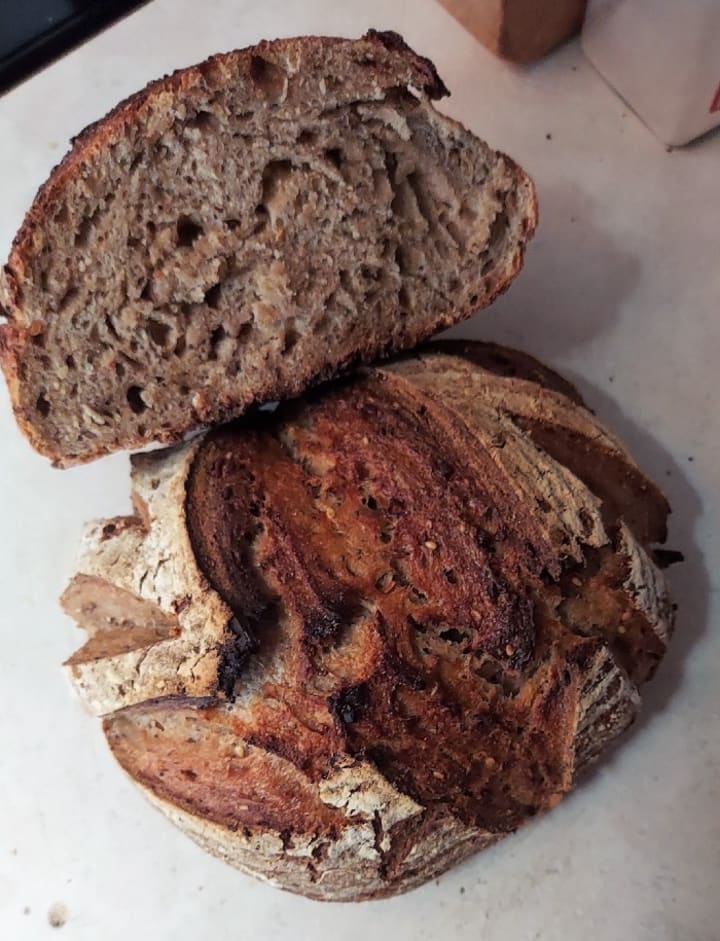Eat The Damn Bread!
Why are you afraid of bread?


This article was originally published here.
I wrote last year about sourdough and not only why you should eat it, but why you should make it. I'm touching on it again to remind you to read up on the benefits of homemade sourdough and also to let you know I started experimenting with additions to my bread and I wanted to share them with you!
You just can't get any easier than this sourdough bread recipe! Three simple ingredients, no manufactured yeast, and fabulous flavor! Give it a whirl!
I wrote that before I started using whole grain flour, which you should definitely try! (keep reading for details)
Man, what a difference!
I didn’t think it could get any yummier but it is!! 🤩
Add This to Your Sourdough, Baby!
I used to eat a slice of sourdough with butter and sprinkle on some everything bagel seasoning.
I’m seriously addicted to everything bagel seasoning. I don’t want to live without it. Is there a 12-step program for that?!
If you’ve never tried it, do it. You won’t regret it.
I recently started experimenting with adding different ingredients to my sourdough and WOW!
You can do an internet search to find all the fun (and weird) stuff people add to their sourdough, but here are a few easy add-ins that I use.
With the exception of wet fruit and veggies, I add all my additions after autolyse. Wet fruits and veggies, I knead into the dough before proofing.
1. Instead of 1 tablespoon of salt in the recipe, only add 1/2 a tablespoon plus 2 heaping tablespoons of everything bagel seasoning. Don’t want the sesame seeds and poppy seeds? Then just add 2 heaping tablespoons of roasted dry onion!
2. I’m going to shout this because you need to hear it and understand the words coming out of my mouth: You can’t add too many herbs to your sourdough! Add fresh or dry, the choice is yours, my friend. Add roughly chopped fresh garlic (yes, all of it, if you want!), sprinkle in rosemary or Italian seasoning. The sky is the limit. Just do it already!
3. For super flavor boost, sprinkle in a little olive oil and then add vegetables like green onion tops, artichoke hearts, sun-dried tomatoes, roasted peppers, zucchini, and mushrooms. Just be mindful of the additional hydration some veggies will lend and adjust the water you add.
4. Do you like seeds and nuts? The crunch factor of sourdough makes me swoon and it will you, too, if you let it! You can kick it up a notch by adding pepitas and sesame seeds with toasted dried onion. Or add walnuts or pecans with a little honey. Yum!
5. Start experimenting by adding your favorite fruit. I like cranberries and orange with walnuts. Play with your favorites!
6. Don’t forget the cheese! Add it with any of the suggestions above, or just make a plain cheese loaf. My fave? Fresh parmesan with garlic. Drool!
Now Let’s Talk About Why The Hell You’re So Afraid Of Bread
Bread has been a staple of our diets for centuries.
It’s been around so freaken long that we can’t agree on how freaken long it’s been around.
“Hey, Google? How long has bread been around?”
Was it 14,000 years?
Or was it 25,500?
No! Wait! It’s 30,000, right?
All I know is that bread is old, it’s tasty, and it (can be) nutritious.

When Did Bread Do Us Dirty?
Archeology in the Fertile Crescent shows that bread was an essential part of life for ancient Mesopotamians and Egyptians.

Ancient Egyptians included bread with fruits and cake as a symbolic offering to nourish their kings and queens in the afterlife.
Medieval lords ate wheat bread, while commoners ate bread made from rye, oats, and barley.
Bread made with a mixture of wheat and other grains continued to sustain people of the early modern era.
So what the hell happened?
Suddenly, we’re afraid to eat a sandwich unless we remove one or both buns?
We won’t even try a slice of local sourdough?
Heaven forbid we eat that extra dinner roll?
Actually, there’s good reason to limit our bread intake these days. The bread we’re eating today is nothing like the bread our ancestors ate. Or, to be more accurate, the flour we’re using today is not the same.
In the late 1800s, we invented machines that filtered out the bran and the germ in whole wheat grain, pulverizing the endosperm into a fine, white powder and voilà. All-purpose white flour was born.
Bakers loved refined flour because it was soft and white. They used it to make all the cakes, cookies, yeast breads, pancakes, biscuits, rolls, crusts, and pasta that we still enjoy today.
The problem with the refining process is that it substantially alters the grain and its benefits. To make white flour, manufacturers filter out the bran and the germ, leaving only the endosperm. Removing the bran and germ removes many of the grain’s nutrients and most of the fiber.
Manufacturers started adding back some of the nutrients they scrubbed from the grains by enriching the white flour. And as with any food manufacturing process, you can imagine the chemical shitstorm that gets stuffed back into the flour to make up for the good stuff they took out of it.
Scientists and nutritionists are still arguing about whether refined flour is good or bad for us, but the simple truth of the matter is that refined flour is super easy to over-consume because most of the fiber is gone and our bodies don’t have to work too hard at converting the remaining starch straight to sugar that gets dumped directly into our bloodstream.
We can point to refined flours as a major contributor to the explosion of metabolic diseases (including diabetes).
Do You Mean I Can’t Ever Eat Bread Again?
Look, the truth is that even though bread has sustained mankind for millennia, our body’s requirement for grains is zero. That’s right.
We don’t need them to live.
But to live well?
Hell yeah, bring the grains!
The trick is to cut your use of refined flours.
Look for whole-grain bread in your local grocery and start using it for your sandwiches. There’s oat, wheat, rye, oh my!
Try to find whole-grain flour for baking. Start out mixing it with half of your refined flours in your recipes, and see how you like it.
Just know that finding whole grain flour is no easy feat, my friend.
If you live on either coast of the U.S., you might have easy access to whole grains and their flour.
If you’re stuck in the middle of the county like the rest of us, you’re probably looking at Amazon as your whole grain source. (unless your town is blessed with a Trader Joe’s!)
You can buy whole grain berries and grind them yourself or you can buy whole grain flour. I like einkorn, but you can mix it up with whole wheat, rye, and oats, too. (Make sure you read the ingredient list so you know you’re buying 100% real grain without additives.)
Whatever you do, be aware that whole grains and whole-grain flours need to be stored properly.
And then? EAT THE DAMN BREAD!!

About the Creator
Donna Sterling
Chase the dream!






Comments
There are no comments for this story
Be the first to respond and start the conversation.